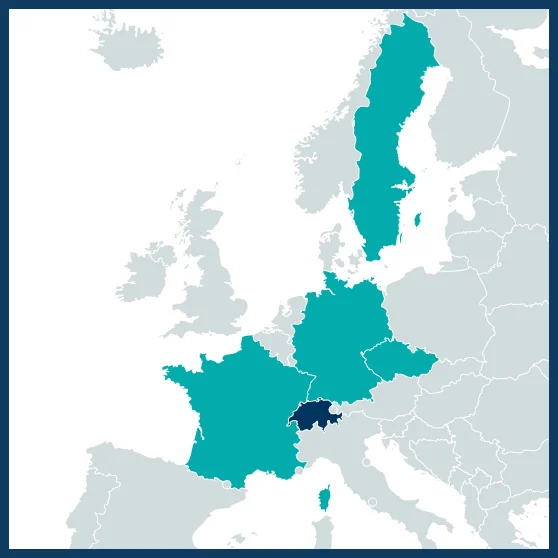01/03/2021 – 28/02/2024
€ 1,480,116
Niklaus E. Zimmermann
niklaus.zimmermann@wsl.ch
Coordinator: Land Change Science – Swiss Federal Research Institute WSL – Birmensdorf – Switzerland
Botany and Zoology – Masaryk University – Brno – Czech Republic
Alpine Ecology (LECA) – University of Grenoble Alpes/ University of Savoie Chambéry/ CNRS – Saint-Martin-d’Hères – France
Biodiversity and Climate – Senckenberg Society for Natural Research -Frankfurt – Germany
Biology / Geobotany and Botanical Garden – Martin Luther University Halle-Wittenberg – Halle – Germany
Stockholm Resilience Center – Stockholm – Sweden
Federal Institute of Technology -Zurich – Switzerland

Terrestrial ecosystems cycle energy, water, chemical elements, and trace gases, and through this influence the climate. To mitigate the effects of global climate and biodiversity change, an improved understanding of the links between these two aspects is essential. Many research projects have studied the effects of climate variation and climate change on biodiversity and related Nature’s contributions to people. However, little is known about the effects of biodiversity on climate and to what degree this feedback can be used to mitigate climate change. For example, a recent study has quantified that the projected warming will likely add an additional 0.1 – 0.25 °C due to increased methane emissions from natural wetlands by the end of the 21st century. But biodiversity change can also mitigate climate change effects through carbon sequestration. More species-rich forests accumulate more biomass, which could result in a 2.7% decrease in carbon storage per year if tree richness in forests decreased by 10%. In summary, biodiversity effects on climate are manifold, but are still widely understudied. This is partly due to the fact that climate or Earth System Models (ESM) only use a very simple parametrisation scheme of biodiversity due to computational limitations. ESMs only differentiate between very broad vegetation classes, such as broadleaved and needle leaved forest or simplified plant functional types. Such simple classifications of the functional diversity do not well represent the processes relevant for addressing biodiversity feedbacks to the atmosphere.
The overall objective of this research is to investigate biodiversity-climate feedbacks by creating an integrated biodiversity-climate model interface. Within this system, various biodiversity components will be randomized or excluded to investigate their effects on climate, and vice-versa. Since biodiversity patterns and changes also affect nature’s contributions to people, we will additionally focus on these contributions, and how nature’s contributions will change in response to changing climates and to changing feedback components.
To fully assess climate-biodiversity feedbacks, FeedBaCks will specifically focus on both, the effects of biodiversity on climate and on nature’s contributions to people. Combining climate models with biodiversity models is however challenging, as i) the combined expertise from a wide variety of fields is required, ii) different model structures and formats need to be combined, and iii) many of the processes linking biodiversity to climate are still unknown. To study feedbacks of biodiversity on the climate system FeedBaCks will use downscaled ESM output and link it to dynamic vegetation and biodiversity models, disentangle the effects of biodiversity, and subsequently feed them back into the ESM to quantify their effect on the climate system. Biodiversity will be quantified by building and benchmarking an effective vegetation classification that is linked to specific plant functional traits, and combined with a set of harmonised plant diversity data across Europe. Based on the quantified effects of biodiversity on the climate system, we will be able to quantify ecosystem functioning and nature’s contributions to people, and provide quantitative predictions of their influence in the biodiversity-climate system.
FeedBaCks integrate a range of stakeholders such as national nature protection agencies or, national parks that have stewardship over biodiversity and are commissioned with its protection. In an initial stakeholder integration workshop, the project will set priorities in the model experimental design relevant to climate change mitigation efforts of these agencies and will choose relevant ecosystem services which are of interest for stakeholders. Over the course of the project we will have a series of workshops, discussing the outcomes of these analysis to foster their implementation in the respective domain of the stakeholders.